
- 首 页 / HOME
- 关 于 / ABOUT
- 2025申奖 / ENTRY
- 获 奖 / AWARDS
- 活 动 / EVENTS
- 资 讯 / NEWS
- 合 作 / PARTNERS
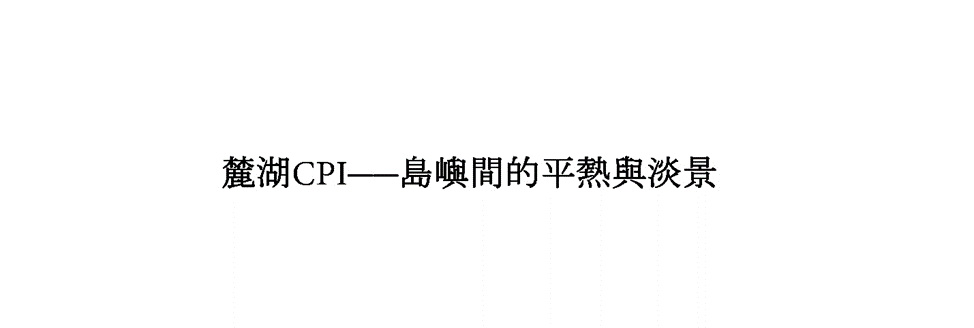
项目概况 | PROJECT OVERVIEW

几里建筑通过一系列系统规划与设计,对其中十栋建筑进行改造加建,并结合地形重新设计新建了十栋建筑,将原有场地的轴线体系和空间关系重新构筑——以新生来致敬过往。
Through a series of systematic planning and design, vari architects renovated
and expanded ten existing buildings, and designed and built ten new buildings
based on the terrain, reconstructing the axis system and spatial relationships
of the original site - paying tribute to the past with a new life.

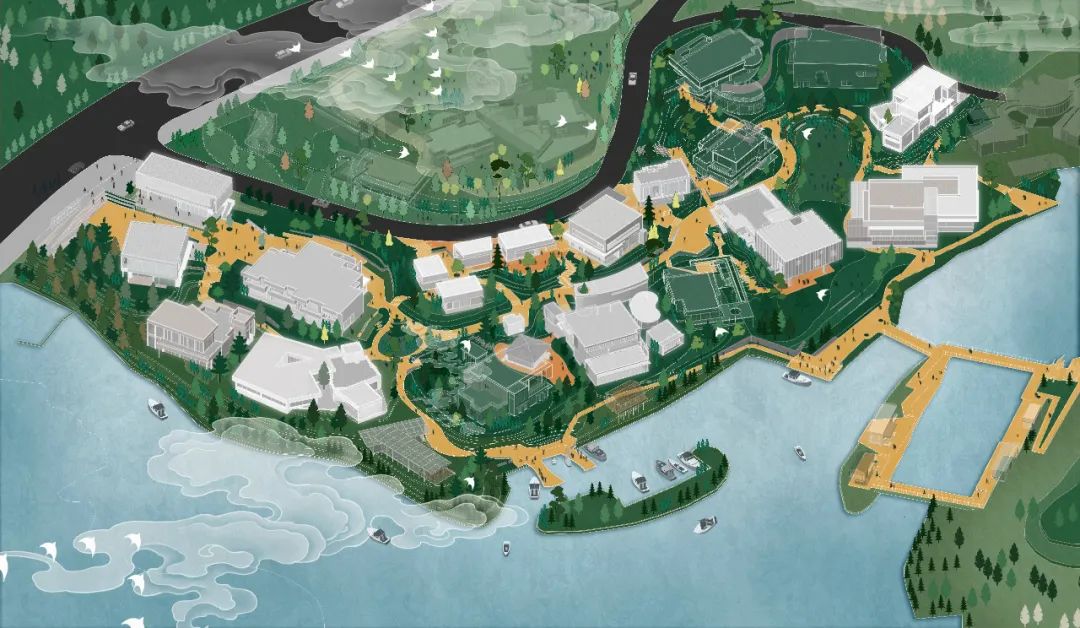
设计理念 | DESIGN CONCEPT
在设计过程中,“平热”和“淡景”这两个由日本哲学家鹫田清一定义的概念对我们有着很大的启发和影响。“平热“意味着一座城市典型或是最平常的状态,彰显其城市的氛围、文化或情绪的本质。
During the design process, two concepts –
“Average Temperature” and “Subtle
Scenery” defined by
Japanese philosopher Washida Kiyokazu, are very inspiring to us. Average
Temperature signifies the typical or ordinary state of things in a city,
capturing the essence or the norm of the city's atmosphere, culture, or mood.

从这一角度来说,也许没有比成都更好的城市氛围环境来塑造充满松弛感的空间。于是很自然的,本项目的设计重点关注如何通过一系列的空间策略来营造属于成都的平热空间,突显其和缓与安逸的城市气质与常态,也就是成都人常说的“巴适”。
From this point of view, there is probably no better setting than Chengdu's to shape a space imbued with a sense of relaxation. So naturally, the design of CPI project lays its emphasis on how to create a space of average temperature specific to Chengdu through a series of spatial strategies, highlighting its urbanistic character and norm of coziness and comfortableness, which Chengdu locals often refer to as “Chill”.
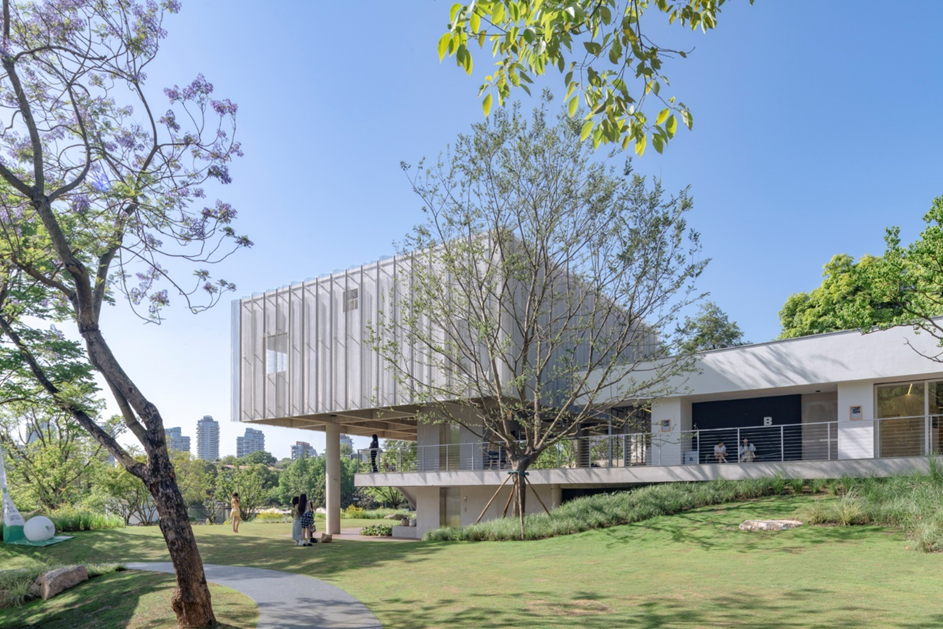
▼ CPI中平热的淡景3, The Subtle Scenery of Average Temperature 3 ©存在建筑摄影

建筑设计策略 | BUILDING
DESIGN APPROACH
在完成整体性的设计后,我们在建筑层面继续追求“平热”,并在此基础上重点探讨了“淡景” 这一理念。淡景或者说“幽隐风景”,指的是我们感官体验和周围环境中那些细腻而常被忽视的方面;其强调关注细微、短暂细节的重要性,即使这些淡淡的风景并不显而易见,但它们通过丰富我们的日常体验,带来一种宁静的美感和深刻的洞察力,从而帮助我们与周围世界建立更深的理解和联系。
After completing the holistic
design, we continued to pursue "Average Temperature" at the
architectural scale and focused on exploring the concept of "subtle
scenery." Subtle scenery, or "subtle landscapes," refers to
those delicate and often overlooked aspects of our sensory experiences and
surroundings.
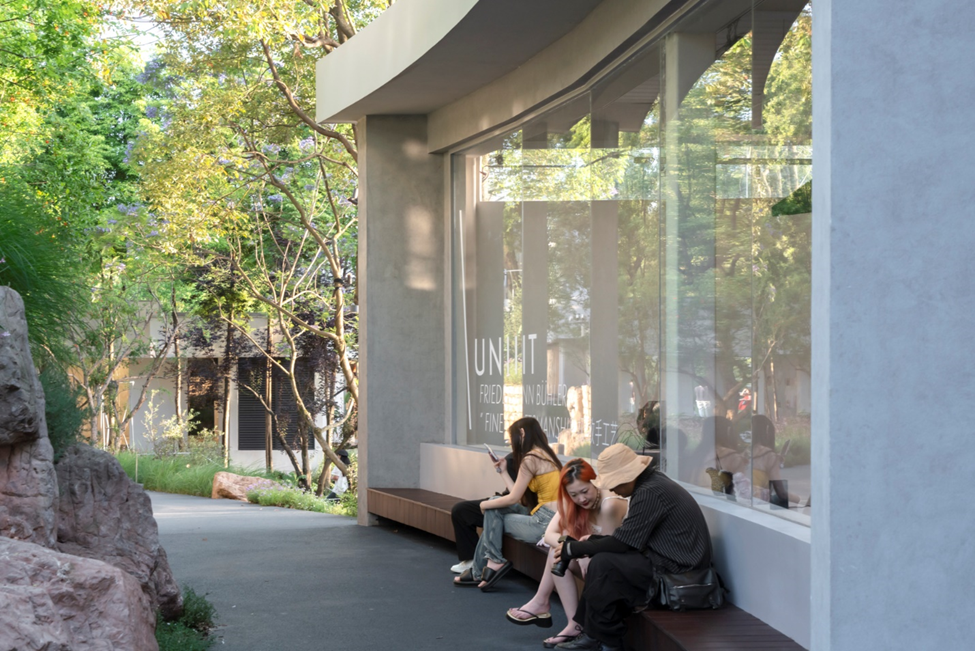
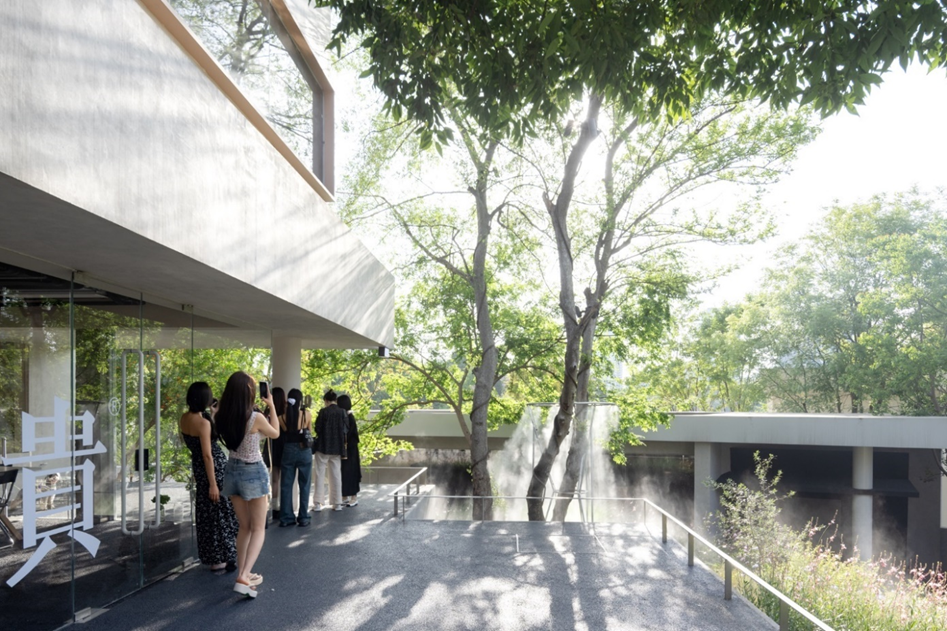
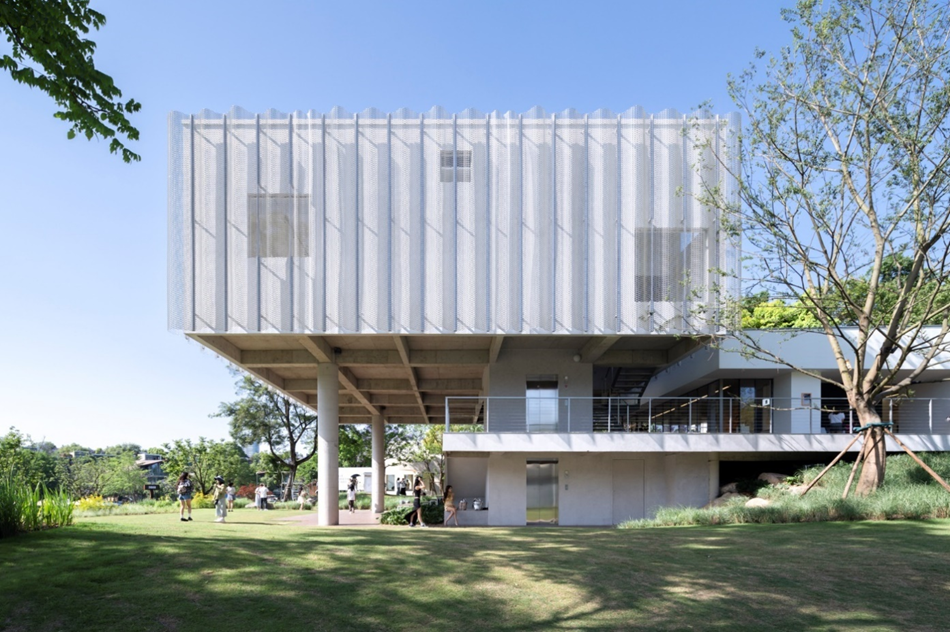
▼ 微地形利用,Micro-topography Utilization ©存在建筑摄影
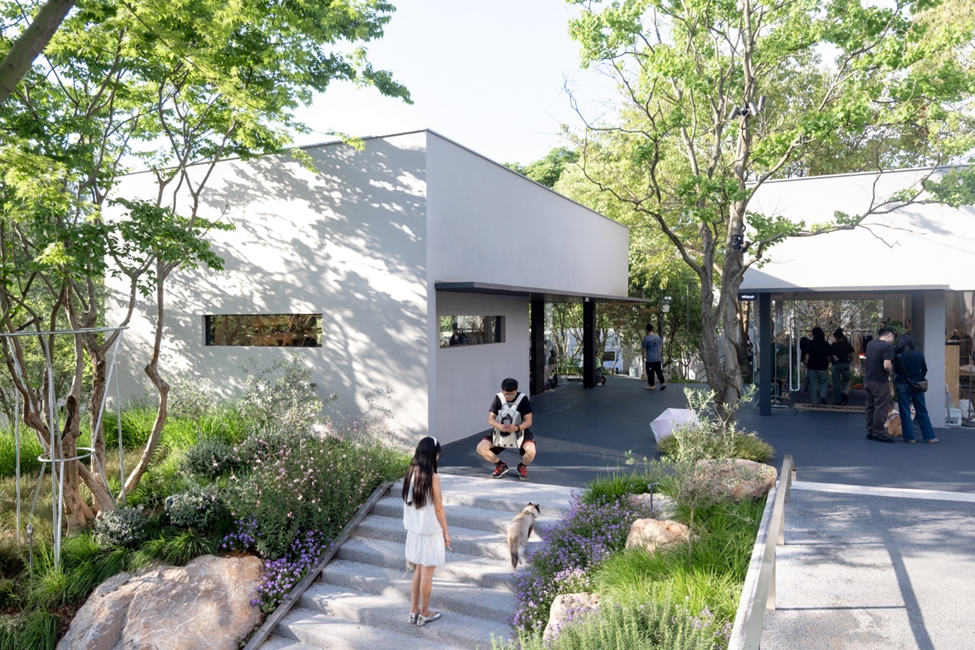
其次是对于灰空间的使用。挑空的设计,把麓客岛的自然生态基地最大限度的引入到了建筑空间,让人、建筑和自然相互融合、淡淡的风景;退台的设计,营造城市社交的空间场景。这两者结合形成既是日常的且具有仪式感的空间。
Secondly, we focused on the use of “gray
spaces/semi-open space”. By incorporating cantilever designs, we maximized the
integration of Luxe Lakes Eco-Island's natural ecology into the architectural
space, blending people, buildings, and nature into a serene landscape; at the
same time, the stepped terraces design fosters urban social spaces. Together,
these elements create spaces that are both everyday and ceremonious.

第三,采用简洁有效的立体主义形式,弱化建筑形体感,使其显得平易近人甚至可爱。第四,强调外立面色调的统一,灰白色色系的基调通过混凝土、涂料、玻璃和金属等不同的材料实现了多元化的表达。
Thirdly, we adopted simple and effective
forms to soften the architectural presence, making it approachable and even
charming. Fourthly, we emphasized a unified color palette for the facade, using
shades of gray and white. This was achieved through a diverse expression of
materials such as concrete, paint, glass, and metal.

几里建筑通过两项关键的“更新”行动来重构CPI岛:
1) 对建筑与自然环境的关系和滨水岸线的更新及空间节点的置入;
2) Renovation and construction of individual
buildings.
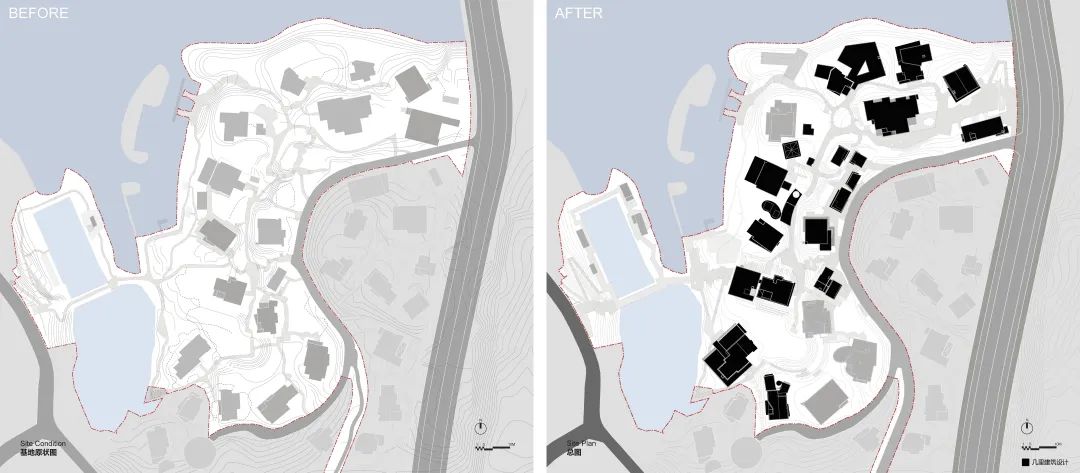
由此,在整体设计层面,我们首先将原先纯功能导向的单动线设计扩展为了提供游历空间体验的三重轴线体系,塑造日常的街道,形成基本空间构架;



▼ 中层动线街景, Middle Level Axis Street View ©青橙摄影

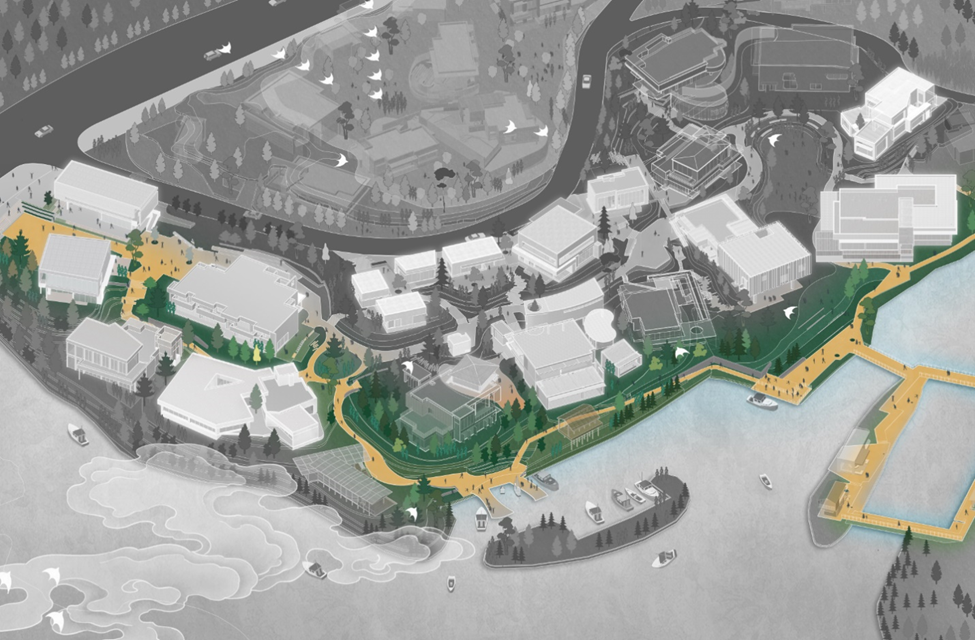
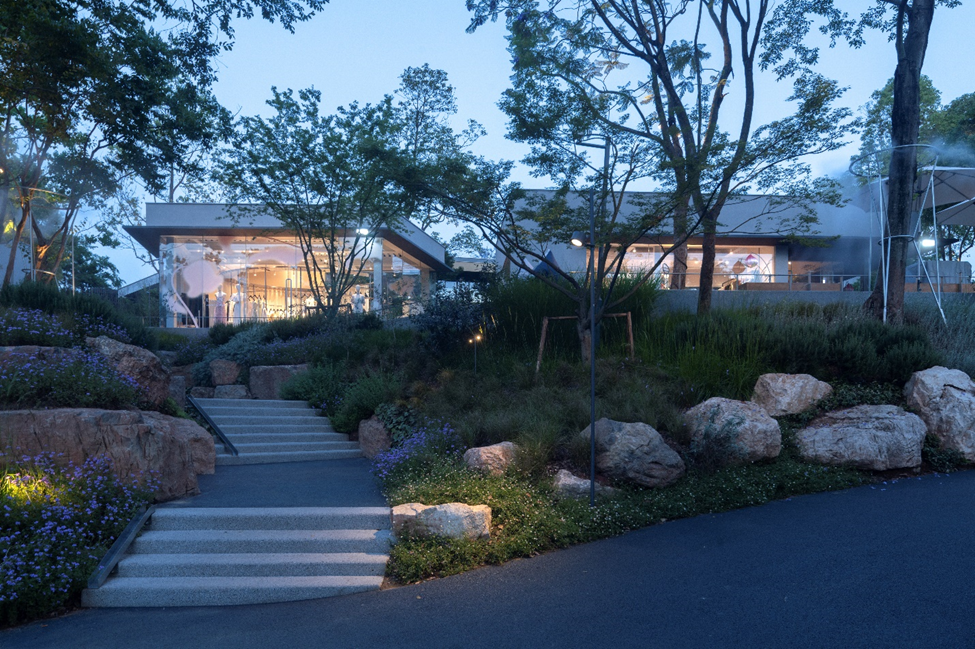
With the architectural function as the core, six natural social spaces with small squares as the core will be developed, providing friendly social areas while creating spatial nodes around them;

根据节点设定六个不同的组群,各自承载相互关联但有不同侧重的功能业态,我们通过新建筑精确介入和现有建筑形态的适当改造,形成了中心导向和半开放的空间聚落,从而将CPI岛的形式从单一建筑类型的离散空间转变成为了包含多种街区形态的“集体形式”。
Thirdly, based on these nodes, we
established six different groups,, we
make precise insertion of new buildings and the proper alteration of the
existing buildings, which as a result transforms the form of CPI from a
dispersed field of singular typology into a “collective form” of varied
morphologies that incorporate both centrality-oriented and semi-open clusters.

▼ 节点三 快闪广场,POP-UP Square ©存在建筑摄影

通过这两步的体系性设计,我们在CPI岛上创造了一个空间网络,邀请游客徜徉和停留、探索和感受,从而呼应和突显了成都的场所精神。
This two-step systematic design action
creates a spatial network on CPI island for visitors to wander and linger as
well as to explore and enjoy, echoing/highlighting the Ge nius-loci of Chengdu
city.
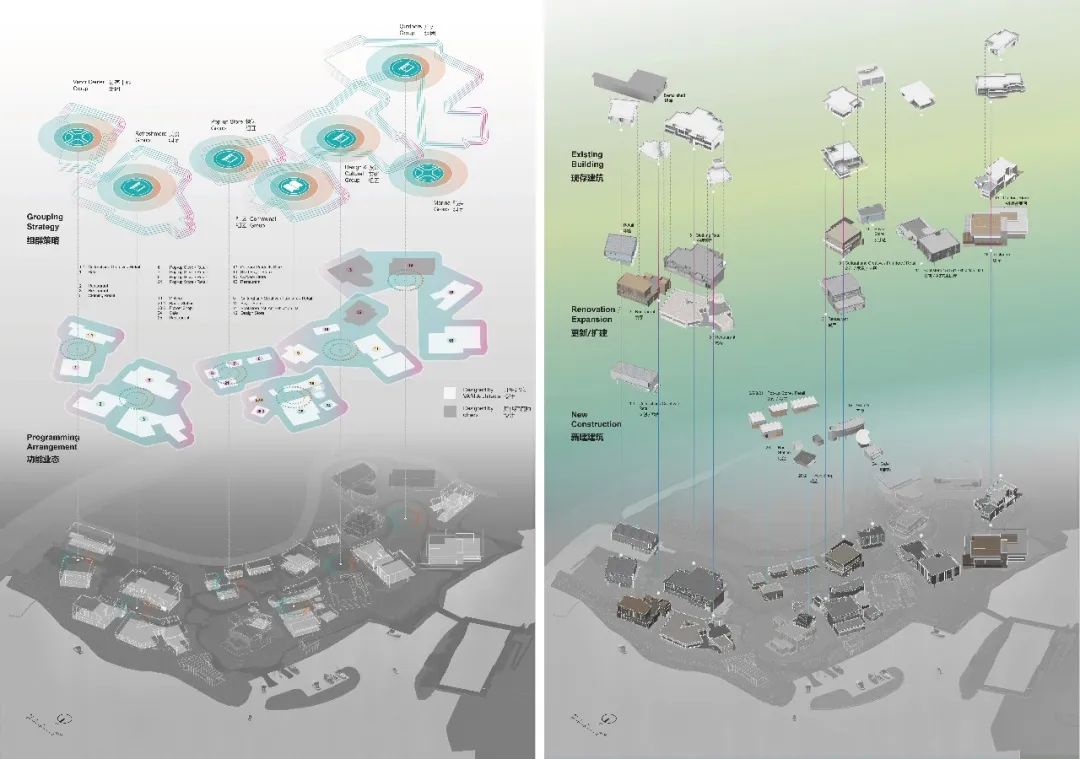
设计详解 | DESIGN DETAILS
建筑部分,包含新建部分10栋和改造部分10栋。
Among all vari architects designed buildings, there are 10 newly built buildings and 10 renovated buildings.
▼ 新建改造详解, Ground Floor Plan ©vari architects 几里建筑
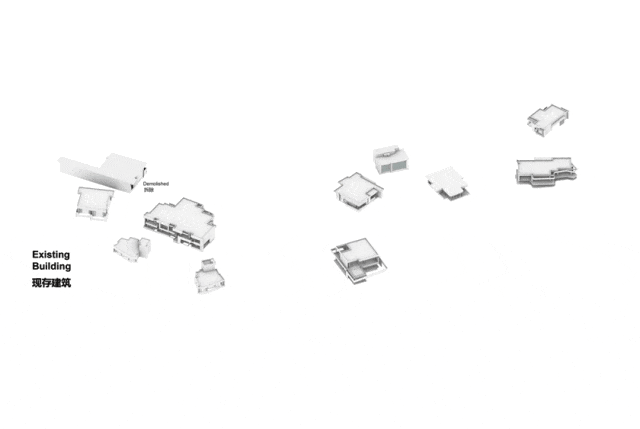
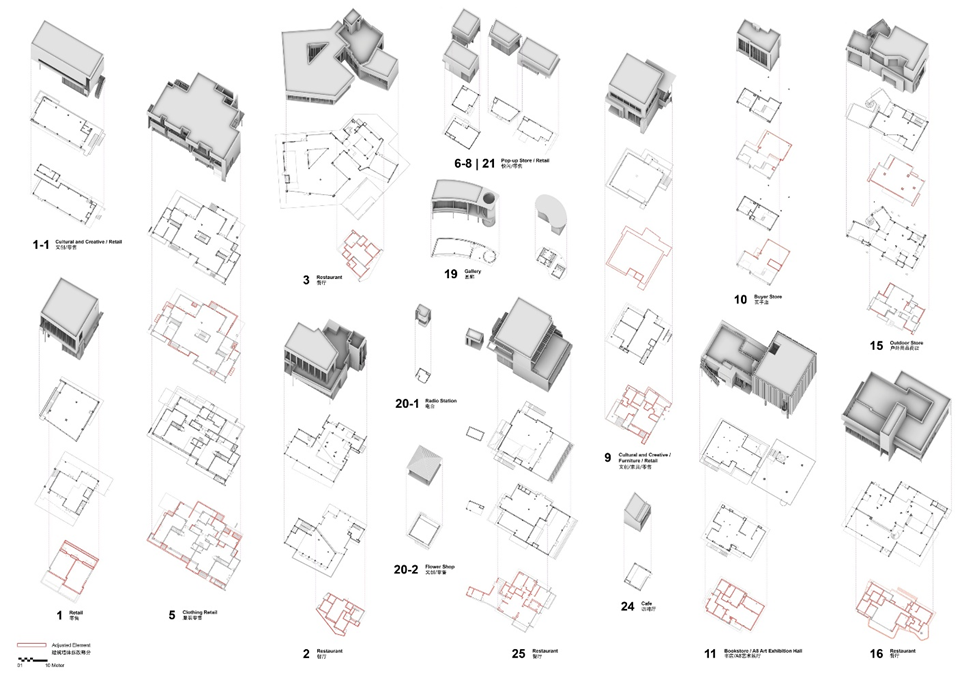
包含w01(改造)w01-1(新建)
在入口处加建二层的w01和新建的w01-1之间,营造出一个极具欢迎感的入口广场,建筑的首层完全打开,向公众开放,让整个空间丰富而轻松。
Add a second floor between w01 and the newly built w01-1 at the entrance, creating a very welcoming entrance square. The first floor of the building is fully open to the public, making the entire space rich and relaxed.



包含w02(改造)w03(改造)w05(改造)
w02,w03分别使用向上生长和水平生长的设计手法,增加了建筑的延续性,形成一个完成的临湖景观面。w05用简洁的手法整合立面,清水质感的涂料搭配彩色的钢柱,更加凸显这栋建筑的几何构成感。
W02
and W03 respectively use upward and horizontal growth design techniques to
increase the continuity of the building, forming a completed lakeside
landscape. W05 integrates the facade with a simple technique, using clear water
textured paint paired with colorful steel columns to further highlight the
geometric composition of this building.
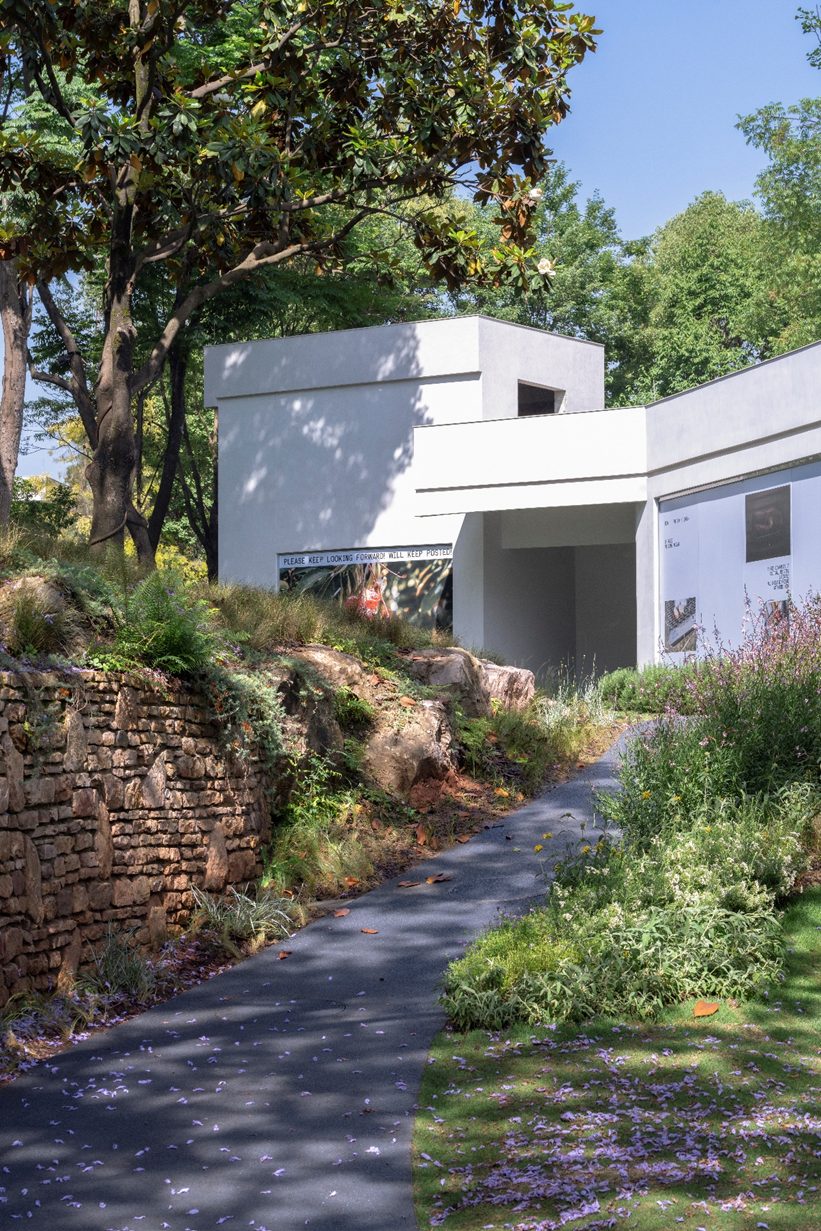



▼ POP-UP W06 & POP-UPW07 ©存在建筑摄影

▼ POP-UP W21 & POP-UP W08 ©存在建筑摄影

▼ POP-UP W07 & POP-UP W08 ©存在建筑摄影

▼ POP-UP W21 ©存在建筑摄影

▼ POP-UP W21 & W09 ©存在建筑摄影

包含w19(新建)w24(新建)w25(改造)w20-1(新建) w20-2(新建)
通过w20-1电台和w19弧形画廊的遮挡,将两个区域的空间通过一条狭长的景观道路串联,本身这道弧形步道也给予人更丰富的空间体验,几个有趣的小建筑构成生活社区组团。
Through the obstruction of the w20-1 radio
station and the w19 curved gallery, the space in the two areas is connected by
a narrow landscape road. This curved walkway itself provides a richer spatial
experience, and several interesting small buildings form a living community group.

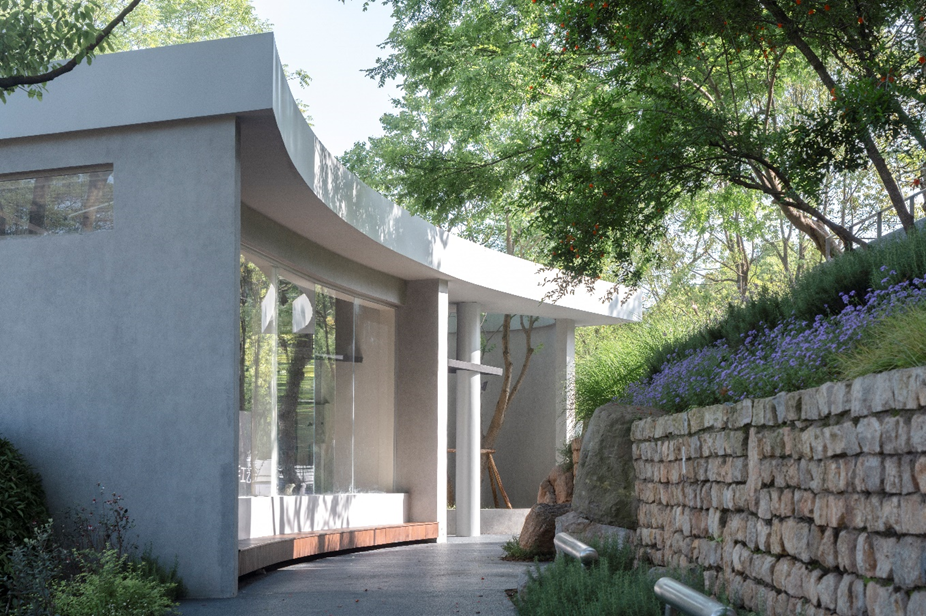
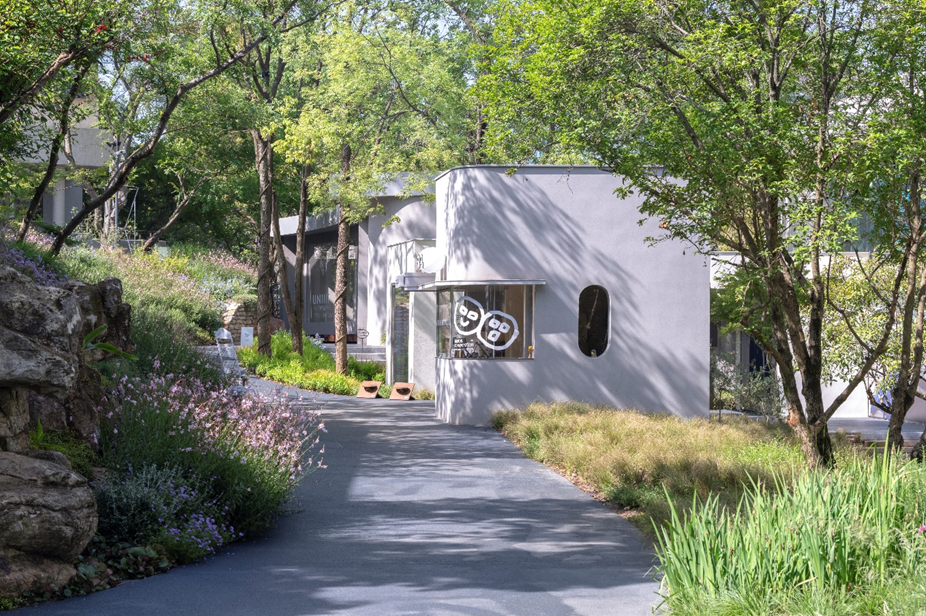
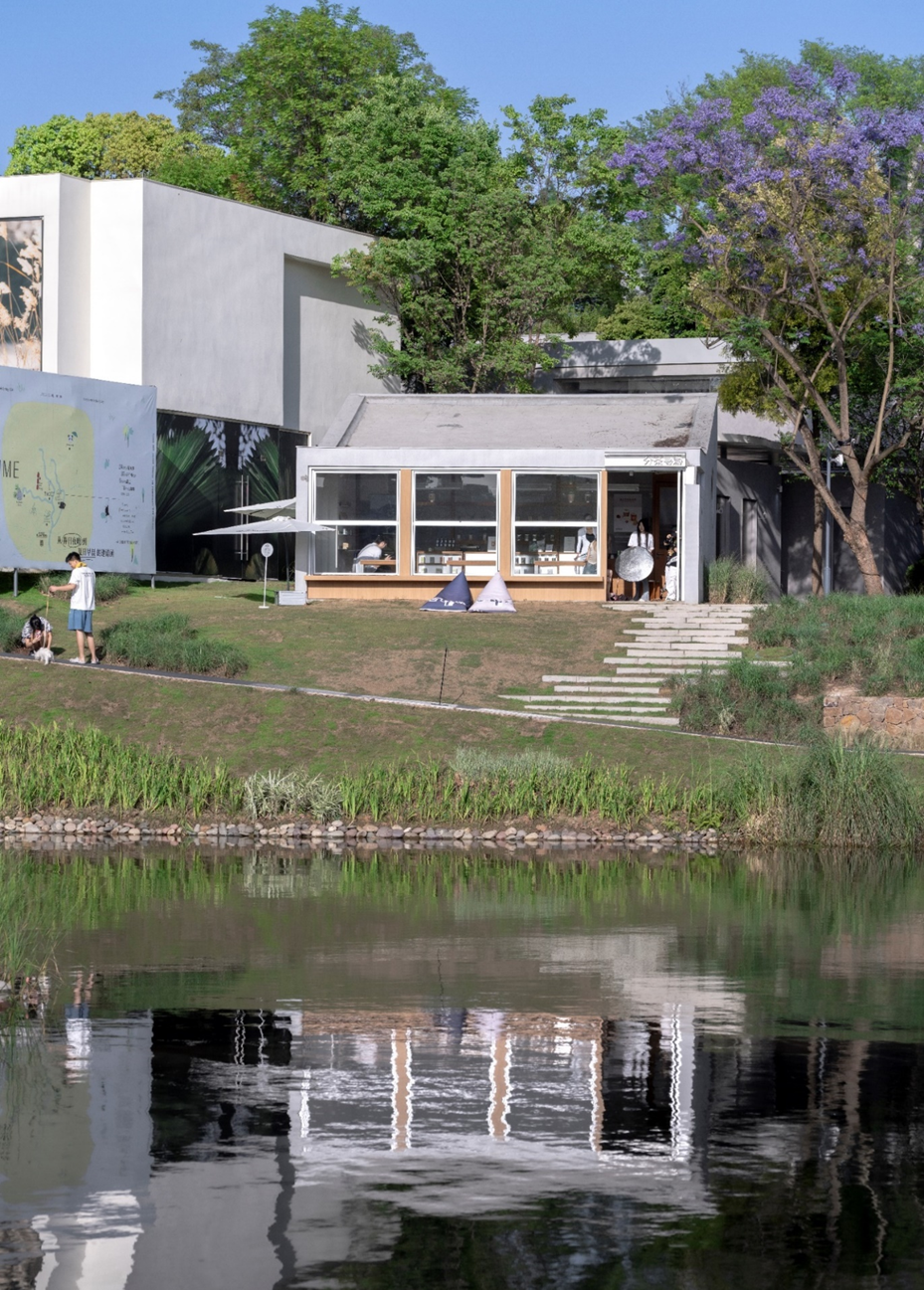
▼ W11 ©存在建筑摄影

▼ W11 ©存在建筑摄影
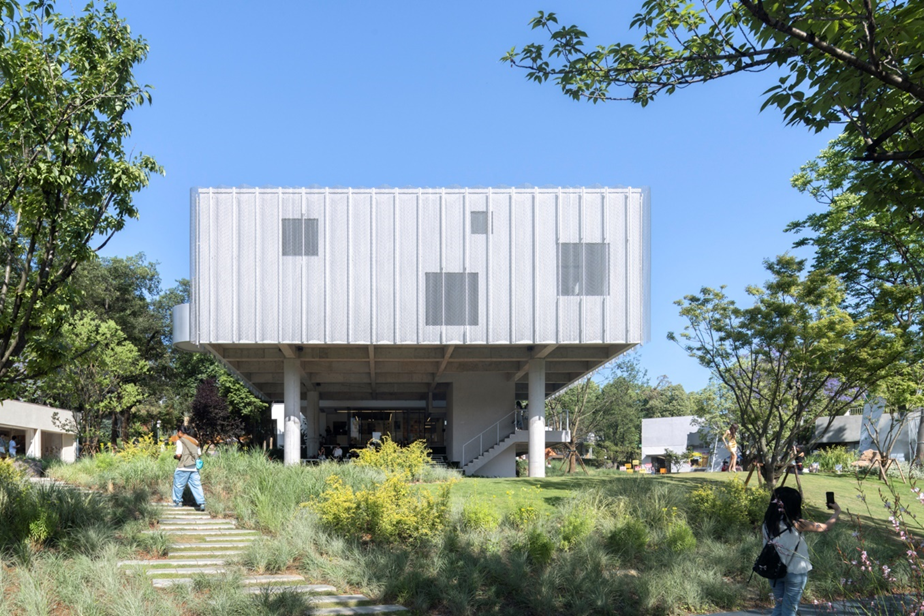
▼ W11 ©存在建筑摄影

▼ W11 ©存在建筑摄影

▼ W11 ©存在建筑摄影

▼ W11 ©存在建筑摄影


总结 | SYNTHESIS
本项目用一种谦逊和克制的态度,重点关注的是如何突显非标和松弛感的场所精神,通过结合现有建筑结构和地形特征来实现平热的淡景之一设计追求,从而探索和展示成都气质的变与不变,希望创造一种新的城市生活方式,为成都合麓湖生态城注入新的城市活力。
This project adopts a humble and restrained approach, focusing on highlighting the spirit of place characterized by a sense of calmness and relaxation. By integrating the existing architectural structures and topographical features, it aims to achieve a design pursuit of average temperatured subtle sceneries. Through this approach, the project explores and showcases the evolving yet enduring essence of Chengdu's urbanistic character.
项目位置:中国 四川省 成都市
项目时间:2022.10 - 2024.4
业主:成都万华投资集团有限公司,成都阿发奇商业管理有限公司
业主设计管理(建筑):
罗希,梁馨尹,李国勤,朱传玺(成都麓湖文化旅游开发有限公司)
柏久绪,王楷文(成都万华新城投资发展股份有限公司)
建筑面积:7000㎡
建筑设计:vari architects 几里建筑
联系邮箱:vari_architects@163.com
主持建筑师:齐帆,杨丁亮
项目建筑师:冯攀遨,王晨欣,唐汉旦,丁小榆,牟羽,李俊
建筑施工单位:图泰建设集团,鼎誉建筑工程有限公司
施工图设计:洲宇设计集团股份有限公司,四川中恒筑科勘测设计有限公司成都第二分公司
景观设计:昱道景观
花镜打造(设计施工一体化):麓湖园艺团队
灯光设计:BPI照明顾问设计公司
幕墙深化设计:洲宇设计集团股份有限公司
摄影:存在建筑,青橙摄影
文案:杨丁亮,齐帆,王晨欣
Project location: Chengdu, Sichuan Province, China
Project time: 2022.10 - 2024.4
Owner: Chengdu Wide Horizon Real Estate
Development Co., Ltd.
Owner Design Management (Architecture):
Xi Luo, Xinyin Liang, Guoqin Li, Chuanxi Zhu;
(Chengdu Luhu Cultural Tourism Development Co., Ltd.)
Jiuxu Bai,Kaiwen Wang
(Chengdu Wide Horizon New City Investment and Development Co., Ltd.)
Building area: 7000 square meters
Architectural Design: vari architects
Contact e-mail:vari_architects@163.com
Lead architects: Fan Qi, Dingliang Yang
Project architects:
Panao Feng, Chenxin Wang, Handan Tang,
Xiaoyu Ding, Mou, Jun Li
Construction unit:
Tutai Construction Group, Dingyu
Construction Engineering Co., Ltd
Construction drawing design: Zhoyu Design Group Co., Ltd.;
Sichuan Zhonghengzhuke
Survey and Design Co., Ltd.
Landscape Design: Yudao Landscape
Flower Mirror Creation: The Luxe Lakes Horticulture Team
Lighting Design: BPI Lighting Consultant Design
Company
Curtain wall deepening design: Zhoyu Design Group Co.,
Ltd.
Photography: Existing Architecture, Blue Orange
Photography
Copywriting: Dingliang Yang, Fan Qi, Chenxin Wang